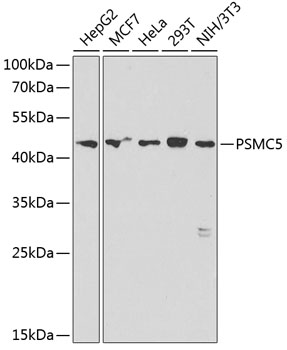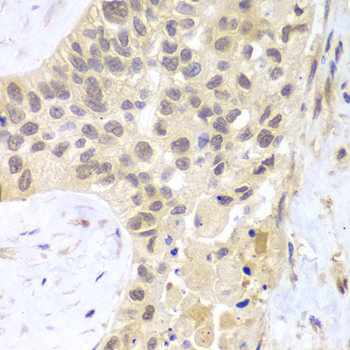-
Product Name
PSMC5 Polyclonal Antibody
- Documents
-
Description
Polyclonal antibody to PSMC5
-
Tested applications
WB, IHC
-
Species reactivity
Human, Mouse
-
Alternative names
PSMC5 antibody; S8 antibody; SUG-1 antibody; SUG1 antibody; TBP10 antibody; TRIP1 antibody; p45 antibody; p45/SUG antibody; proteasome 26S subunit, ATPase 5 antibody
-
Isotype
Rabbit IgG
-
Preparation
Antigen: Recombinant fusion protein containing a sequence corresponding to amino acids 127-406 of human PSMC5 (NP_002796.4).
-
Clonality
Polyclonal
-
Formulation
PBS with 0.02% sodium azide, 50% glycerol, pH7.3.
-
Storage instructions
Store at -20℃. Avoid freeze / thaw cycles.
-
Applications
WB 1:500 - 1:2000
IHC 1:50 - 1:200 -
Validations

Western blot - PSMC5 Polyclonal Antibody
Western blot analysis of extracts of various cell lines, using PSMC5 antibody at 1:1000 dilution.Secondary antibody: HRP Goat Anti-Rabbit IgG (H+L) at 1:10000 dilution.Lysates/proteins: 25ug per lane.Blocking buffer: 3% nonfat dry milk in TBST.

Immunohistochemistry - PSMC5 Polyclonal Antibody
Immunohistochemistry of paraffin-embedded human lung cancer using PSMC5 antibody at dilution of 1:100 (40x lens).
-
Background
Component of the 26S proteasome, a multiprotein complex involved in the ATP-dependent degradation of ubiquitinated proteins. This complex plays a key role in the maintenance of protein homeostasis by removing misfolded or damaged proteins, which could impair cellular functions, and by removing proteins whose functions are no longer required. Therefore, the proteasome participates in numerous cellular processes, including cell cycle progression, apoptosis, or DNA damage repair. PSMC5 belongs to the heterohexameric ring of AAA (ATPases associated with diverse cellular activities) proteins that unfolds ubiquitinated target proteins that are concurrently translocated into a proteolytic chamber and degraded into peptides.
Related Products / Services
Please note: All products are "FOR RESEARCH USE ONLY AND ARE NOT INTENDED FOR DIAGNOSTIC OR THERAPEUTIC USE"
